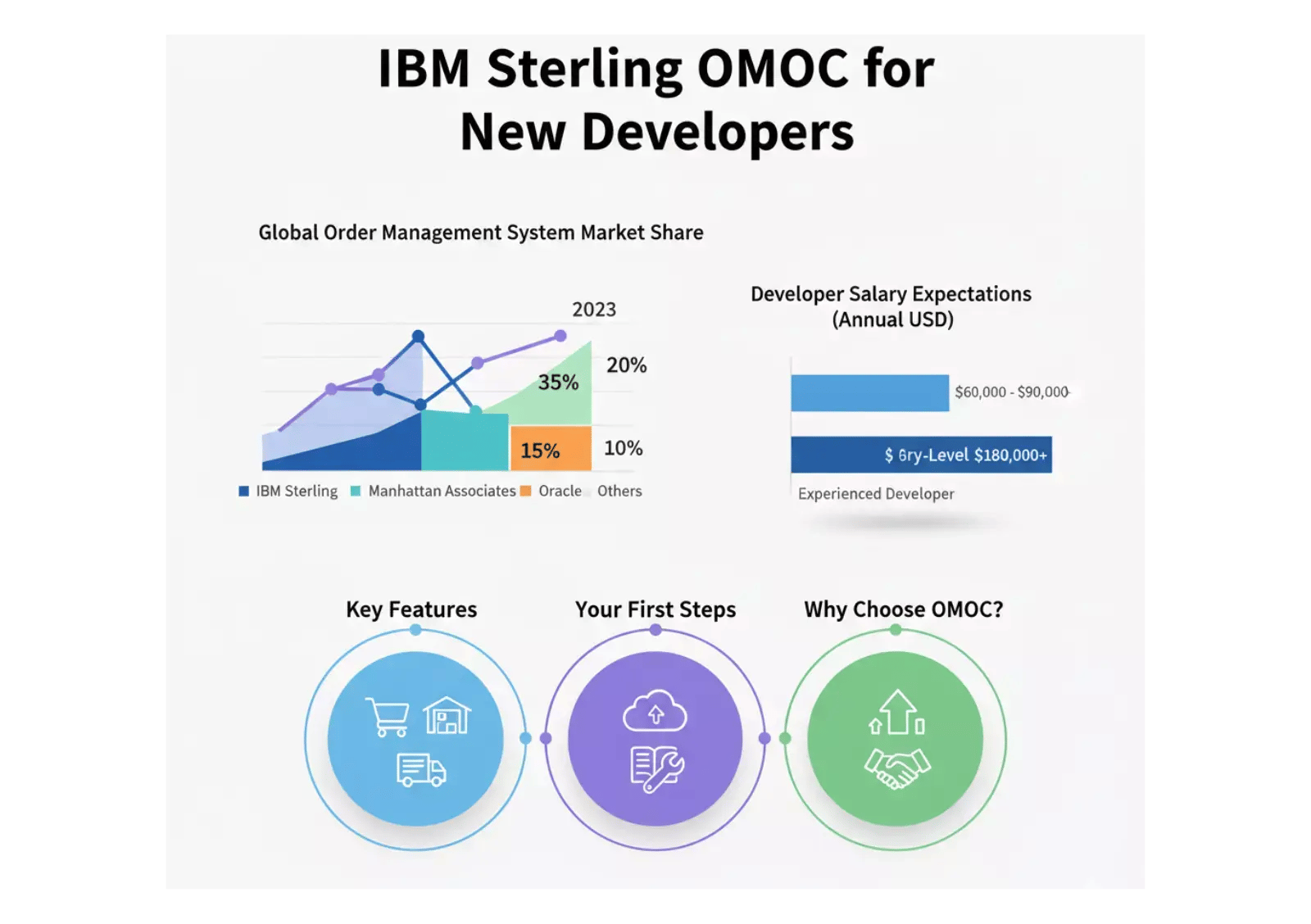IBM Sterling OMOC for New Developers: Your First Steps on the Cloud
Welcome, aspiring developers! Are you ready to dive into the world of cloud-based order management and fulfillment? If so, IBM Sterling Order Management on Cloud (OMOC) is an excellent place to start. This blog post will guide you through your first steps, providing valuable insights for beginners, and even touching upon the market landscape and career opportunities.
What is IBM Sterling OMOC?
At its core, IBM Sterling OMOC is a robust, cloud-native solution designed to manage the entire order lifecycle, from capture to fulfillment and returns. It helps businesses deliver seamless customer experiences by providing a unified view of inventory, orders, and customer data across multiple channels.
Think of it this way: when you order something online, there's a complex dance happening behind the scenes to ensure your item is located, picked, packed, shipped, and delivered to your doorstep. IBM Sterling OMOC orchestrates this entire process, making it efficient and transparent for both businesses and customers.
Key Features for Beginners to Understand:
- Order Capture: How orders are received from various sources (e.g., e-commerce websites, mobile apps, call centers).
- Inventory Management: Real-time visibility into product availability across all locations (warehouses, stores, in-transit).
- Order Fulfillment: Determining the best way to fulfill an order, considering factors like shipping costs, delivery times, and inventory proximity.
- Distributed Order Management (DOM): The ability to intelligently route orders to the most optimal fulfillment locations.
- Returns Management: Streamlining the process of product returns and exchanges.
- Cloud-Native Architecture: This means it's built to leverage the scalability, flexibility, and reliability of cloud platforms.
Why Choose IBM Sterling OMOC?
-
Market Leadership: IBM Sterling Order Management has a long-standing reputation as a leader in the order management system (OMS) space. Its cloud offering continues this legacy, providing a powerful and scalable solution for businesses of all sizes.
-
Scalability and Flexibility: Being on the cloud, OMOC can easily scale up or down based on business needs, handling peak seasons without breaking a sweat.
-
Reduced IT Overhead: Businesses can focus on their core competencies rather than managing complex on-premise infrastructure. IBM handles the heavy lifting of maintenance, upgrades, and security.
-
Integration Capabilities: OMOC is designed to integrate seamlessly with other enterprise systems like ERP, CRM, and WMS, creating a holistic view of operations.
Your First Steps as a New Developer
Getting started with IBM Sterling OMOC involves a combination of understanding its architecture, learning its core functionalities, and familiarizing yourself with its development tools.
1. Understand the Basics of Cloud Computing:
If you're new to cloud, take some time to grasp fundamental concepts like:
- SaaS (Software as a Service): OMOC is primarily a SaaS offering.
- PaaS (Platform as a Service): While OMOC is SaaS, understanding PaaS will help you grasp the underlying infrastructure.
- Microservices: Cloud-native applications often use microservices architecture.
- APIs (Application Programming Interfaces): These are crucial for integrating OMOC with other systems.
2. Explore the IBM Documentation:
The official IBM documentation is your best friend. It contains detailed guides, API references, and tutorials. Start with the "Getting Started" sections and gradually move to more advanced topics.
3. Familiarize Yourself with Customization Options:
While OMOC provides out-of-the-box functionalities, businesses often require customizations to meet their unique needs. As a developer, you'll be involved in:
- Extending User Exits: These are points in the system where you can inject custom logic.
- Developing Custom Services: Creating new services to handle specific business requirements.
- UI Customizations: Modifying the user interface to align with branding or specific workflows.
- API Integrations: Building connectors to exchange data between OMOC and other applications.
4. Hands-on Experience:
The best way to learn is by doing. Seek opportunities to work on small projects or participate in proof-of-concept initiatives. If possible, get access to a sandbox environment to experiment with configurations and customizations.
5. Join the Community:
Engage with the IBM Sterling developer community. Forums, user groups, and online discussions are invaluable for asking questions, sharing knowledge, and learning from experienced professionals.

Market Share and Career Opportunities
The market for order management systems is robust and growing, driven by the increasing complexity of e-commerce and omnichannel retail. IBM Sterling Order Management holds a significant position in this market.
Global Order Management System Market Share (Illustrative) This chart represents an illustrative view of the market, actual figures may vary.
This strong market presence translates into excellent career opportunities for developers skilled in IBM Sterling OMOC. Companies are constantly looking for talent to implement, customize, and maintain these critical systems.
Developer Salary Expectations (Annual USD - Illustrative) Salaries can vary significantly based on experience, location, and specific company.
- Entry-Level Developer: $60,000 - $90,000
- Experienced Developer: $90,000 - $150,000+
- Senior/Lead Developer: $150,000 - $180,000+
- Architect/Consultant: $180,000+
These figures are illustrative and can fluctuate based on market demand, specific skill sets, and geographic location. However, they demonstrate the strong earning potential for developers specializing in this domain.
Essential Skills for an OMOC Developer
Beyond the technical aspects of OMOC, cultivating these skills will accelerate your career:
- Java Programming: OMOC is heavily based on Java, so a strong understanding is essential.
- XML/XSLT: Used extensively for data transformation and configuration.
- SQL (Database Knowledge): For understanding data structures and querying.
- Problem-Solving: Debugging and troubleshooting are daily tasks.
- Communication: Clearly articulating technical concepts to non-technical stakeholders.
- Business Acumen: Understanding the retail and supply chain domain will make you a more effective developer.
The Future is Cloud
The trend towards cloud-based solutions is undeniable. By investing your time in learning IBM Sterling OMOC, you're not just learning a product; you're gaining valuable skills in cloud-native development, enterprise system integration, and critical supply chain processes.
Conclusion
Embarking on your journey with IBM Sterling OMOC as a new developer is a smart move. The demand for skilled professionals in this area is high, and the platform offers a rich environment for learning and growth. Start with the basics, leverage the available resources, get hands-on experience, and actively participate in the community. Your first steps on the cloud with IBM Sterling OMOC can lead to a rewarding and impactful career!
You May Also Like
These Related Stories

IBM Sterling OMOC: A Beginner’s Guide

Master SAP FICO in S/4HANA: Step-by-Step Guide for Freshers


No Comments Yet
Let us know what you think